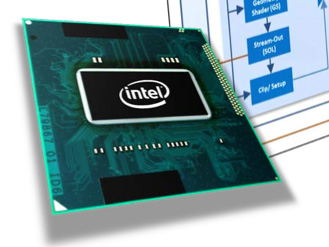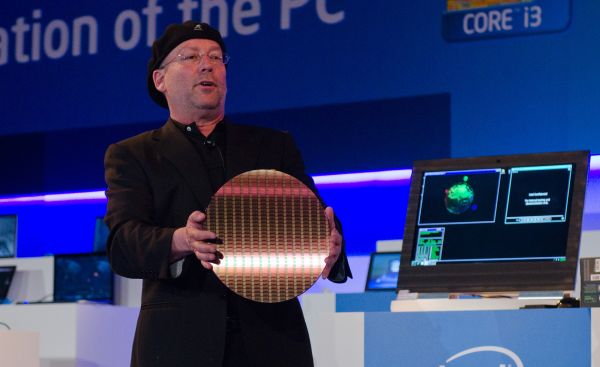Intel's Ivy Bridge Architecture Exposed
by Anand Lal Shimpi on September 17, 2011 2:00 AM EST- Posted in
- CPUs
- Intel
- Ivy Bridge
- IDF 2011
- Trade Shows
Five years ago Intel announced its ambitious tick-tock release cadence. We were doubtful that Intel could pull off such an aggressive schedule but with the exception of missing a few months here or there tick-tock has been a success. On years marked by a tick Intel introduces a new manufacturing process, while tock years keep manufacturing process the same and introduce a new microprocessor architecture. To date we've had three tocks (Conroe, Nehalem, Sandy Bridge) and two ticks (Penryn, Westmere). Sampling by the end of this year and shipping in the first half of next year will be Intel's third tick: Ivy Bridge.

Ivy Bridge (IVB) is the first chip to use Intel's 22nm tri-gate transistors, which will help scale frequency and reduce power consumption. As we already mentioned, mobile Ivy Bridge will be the first Intel CPU to bring four cores into a 35W TDP.
At a high level Ivy Bridge looks a lot like Sandy Bridge. It's still a monolithic die that features an integrated GPU. The entire die is built at 22nm, continuing Intel's march towards truly addressing integrated graphics performance. Ivy Bridge won't get rid of the need for a discrete GPU but, like Sandy Bridge, it is a step in the right direction.

Intel hasn't announced die size but transistor count has increased to approximately 1.4 billion (layout). This is up from 1.16 billion in Sandy Bridge, a 20.7% increase. With perfect scaling a 22nm Sandy Bridge die would be 47.3% the size of a 32nm die. Even with the increase in transistor count, it's a good bet that Ivy Bridge will be noticeably smaller than Sandy Bridge.
Motherboard & Chipset Support
Ivy Bridge is backwards compatible with existing LGA-1155 motherboards, although there will be a new chipset for Ivy Bridge and new motherboards to enable some features (e.g. PCI Express 3.0, native USB 3.0). The new chipset family falls under the 7-series banner. We'll see Z77, Z75, H77, Q77, Q75 and B75 available at or around launch.
| Chipset Comparison | ||||||||
| Z77 | Z75 | H77 | Z68 | P67 | H67 | |||
| CPU Support |
IVB LGA-1155 |
IVB LGA-1155 |
IVB LGA-1155 |
SNB/IVB LGA-1155 |
SNB/IVB LGA-1155 |
SNB/IVB LGA-1155 |
||
| CPU Overclocking | Yes | Yes | No | Yes | Yes | No | ||
| CPU PCIe Config |
1 x16 or 2 x8 or 1 x8 + 2 x4 PCIe 3.0 |
1 x16 or 2 x8 PCIe 3.0 |
1 x16 PCIe 3.0 |
1 x16 or 2 x8 or 1 x8 + 2 x4 PCIe 3.0 |
1 x16 or 2 x8 PCIe 3.0 |
1 x16 PCIe 3.0 | ||
| Processor Graphics Support | Yes | Yes | Yes | Yes | No | Yes | ||
| Intel SRT (SSD caching) | Yes | No | Yes | Yes | No | No | ||
| RAID Support | Yes | Yes | Yes | Yes | Yes | Yes | ||
| USB 2.0 Ports (3.0) | 14 (4) | 14 (4) | 14 (4) | 14 | 14 | 14 | ||
| SATA Total (Max Number of 6Gbps Ports) | 6 (2) | 6 (2) | 6 (2) | 6 (2) | 6 (2) | 6 (2) | ||
| PCIe Lanes | 8 (5GT/s) | 8 (5GT/s) | 8 (5GT/s) | 8 (5GT/s) | 8 (5GT/s) | 8 (5GT/s) | ||
As I mentioned above, Ivy Bridge finally supports USB 3.0 natively. The consumer 7-series chipsets feature 14 total USB ports, 4 of which are USB 3.0 capable. The CPU itself features 16 PCIe (1x16, 2x8 or 1x8 + 2x4) gen 3 lanes to be used for graphics and/or high performance IO. You will only see Gen 3 speeds on qualified motherboards. It's technically possible on 6-series motherboards but guaranteed on 7-series motherboards. The Z77 and H77 chipsets will support Intel's Smart Response Technology (SRT, aka SSD caching) which is a Z68 exclusive today.
SATA and chipset-attached PCIe slots haven't changed. Overclocking is supported on all Z-chipsets, while the H-chipset doesn't. All chipsets support Intel's HD Graphics, which is a departure from the Sandy Bridge mess where P67 didn't.










97 Comments
View All Comments
Meegulthwarp - Saturday, September 17, 2011 - link
Thanks man, you're a star. You really should just ignore whiny comments like mine as you provide some of the best (if not the best) tech articles online and its free of charge! Everytime you push a article like this my life comes to a standstill so I can read it. Keep up the good work!zshift - Saturday, September 17, 2011 - link
I agree with this 100%. I love reading the articles here on AnandTech. The articles are well written, and provide plenty of charts/data/photos to provide as much of a complete understanding as possible of the product in question.I also like the fairly recent upsurge in articles, you have a great team here.
PS: Bench rocks!
lowenz - Saturday, September 17, 2011 - link
From power page: "Voltage changes have a cubic affect on power"Cubic?
P ~ C * v^2 * freq * switching activity
know of fence - Saturday, September 17, 2011 - link
Cubic as in "to the third power".I remember a slide from on of the Intel presentations saying that, but i'd like to know how it comes about.
Vcore^3 ~ power
Here somebody posted some data of Vcore vs Power. If you were to plot power consumption in relation to Vcore^3 then one ought to get a linear graph.
http://www.awardfabrik.de/forum/showthread.php?t=6...
KalTorak - Saturday, September 17, 2011 - link
Cubic. Because f, for a big chunk of the V-f curve, tends to be linear in V.gevorg - Saturday, September 17, 2011 - link
Will IVB have 8-core unlocked CPUs like 2500K/2600K SNB?Sabresiberian - Saturday, September 17, 2011 - link
"Ivy Bridge won't get rid of the need for a discrete GPU but, like Sandy Bridge, it is a step in the right direction."I'm not so sure I'd agree getting rid of the need for a discrete GPU is a good thing. In terms of furthering technological possibilities, yes, I get that; in terms of me building the computer I want to build and tailoring the results to my purposes, I really don't want these things to be tied together in an inflexible way.
;)
platedslicer - Sunday, September 18, 2011 - link
Standardization seems to be the current trend... next thing you know, the computer industry has gone the way of car manufacturers.JonnyDough - Monday, September 19, 2011 - link
Standards are not all bad. In the case of car manufacturers, we now have things like sealed bearings (so you don't have to regularly grease the bearings in your wheels, and they actually last longer and cost less), safety systems like ABS, seat belts, airbags, etc.With computers, we need standards as well for compatibility. It lowers cost, ensures that hardware works fluidly between platforms, etc. If we didn't have standards we would have things like rambus - which would only cost us a fortune and slow technological progression.
JonnyDough - Monday, September 19, 2011 - link
I think the author means that you won't NEED a discrete CHIP (GPU other than the one on-die) to run a system. Discrete here seems to imply an IGP (integrated onto the motherboard) OR on a separate graphics card. That isn't to say one won't still be required for graphics intensive applications. Ideally, the on-die GPU will be able to work in tandem when a graphics card is installed.